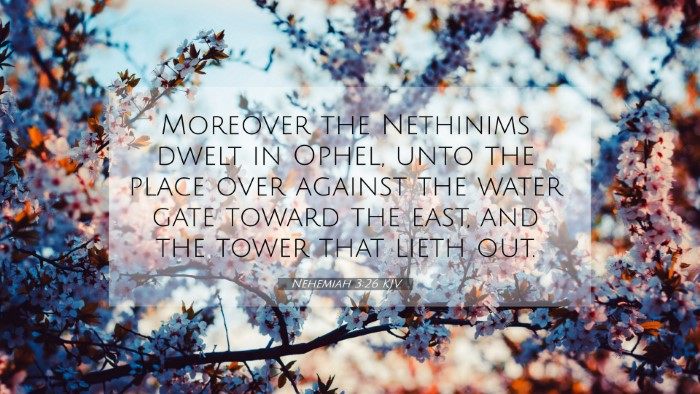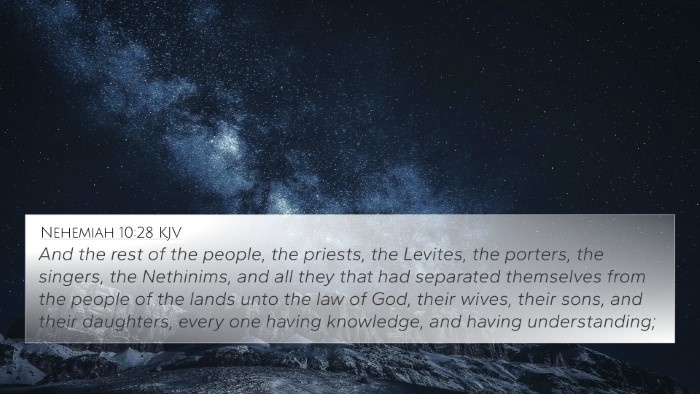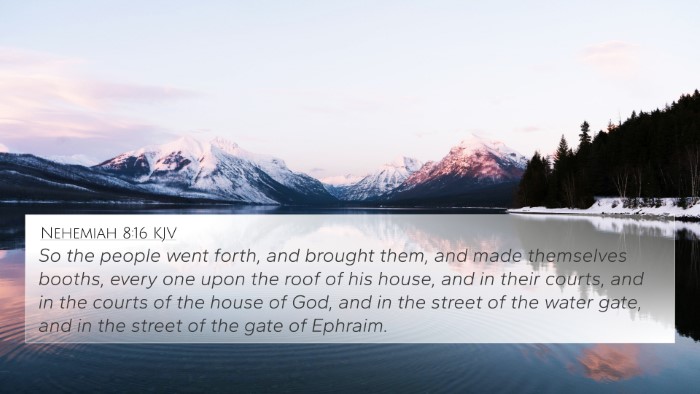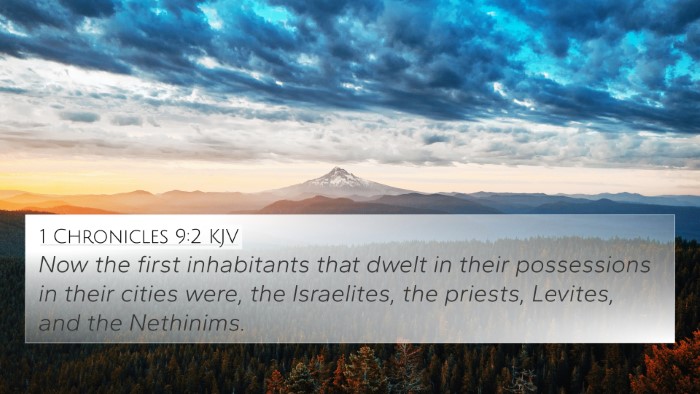Understanding Nehemiah 3:26
Nehemiah 3:26 states, "Moreover, the Nethinim dwelt in Ophel, unto the place over against the water gate toward the east, and the tower that lieth out." This verse is part of a passage detailing the reconstruction of Jerusalem’s walls and the roles different groups played in this critical task.
Contextual Background
An understanding of Nehemiah 3:26 requires an appreciation of the historical context. Nehemiah, serving as governor of Judah, is leading the effort to rebuild Jerusalem after the exile. This chapter lists the different sections of the wall and the individuals or groups responsible for each section. The mention of the Nethinim reflects their designated roles within the community.
Commentary Insights
- Matthew Henry: Henry explains that the Nethinim were temple servants, dedicated to helping with the religious practices and maintaining the sanctuary. Their role in the rebuilding effort signifies the importance of spiritual dedication in physical rebuilding.
- Albert Barnes: Barnes notes that the specifics of the location "over against the water gate" connect this verse to themes of community resource management, as access to water was critical for any reconstruction effort. It may symbolize refreshment and vital life in the city.
- Adam Clarke: Clarke emphasizes that the placement of the Nethinim indicates their commitment to restoring the community’s religious and social order, underscoring a theme of cooperation among the people of Judah.
Thematic Connections
Nehemiah 3:26 can be understood through various themes and connections with other Bible verses:
- Community and Cooperation: The collaborative efforts in rebuilding Jerusalem draw parallels with Romans 12:4-5, which speaks of many members forming one body in Christ.
- Spiritual Restoration: This connects with Isaiah 58:12, emphasizing the rebuilding of ancient ruins and restoration.
- Service and Dedication: Servants, like the Nethinim, reflect the call to service found in Mark 10:45, where Jesus came not to be served but to serve.
- Physical and Spiritual Renewal: Ezekiel 36:26 speaks of a new heart and spirit, paralleling the physical efforts to restore the city with a spiritual revival.
- Purpose in Labor: Colossians 3:23 discusses working heartily as for the Lord, closely relating to the endeavors of the Nethinim.
- The Role of Leaders: Nehemiah's leadership echoes the themes found in Proverbs 11:14 about the safety found in a multitude of counselors.
- The Connection to God's Promises: Jeremiah 29:11 relates to God's plans for restoration and hope, a theme echoed in Nehemiah's mission.
Bible Verse Cross-References
Here are some pertinent verses that highlight connections to Nehemiah 3:26:
- 1 Chronicles 9:2: Discussing the priests and temple servants, showing continuity of service.
- Ezra 2:43: Listing the Nethinim and providing insight into their roles within the post-exilic community.
- 2 Samuel 15:24: Highlighting the role of priests and Levites, tying to the religious duties of the Nethinim.
- John 17:18: Jesus sends His disciples into the world as He was sent, indicating the theme of mission and service.
- Nehemiah 9:38: The community's dedication to a covenant to restore spiritual order.
- 1 Peter 2:9: As a royal priesthood, reflecting the service and dedication seen in the Nethinim.
- Isaiah 61:4: The rebuilding of ancient ruins and laying foundations for generations.
Conclusion
Nehemiah 3:26 serves as a crucial verse within the Larger narrative of restoration and community effort. By examining its connections through various commentaries and scripture, one may gain deeper insight into the significance of rebuilding not only physical structures but also communal and spiritual life. This holistic lens reveals how the physical act of rebuilding the wall signifies a deeper spiritual renewal, emphasizing engagement, cooperation, and dedication, both historically and in contemporary faith practices.














